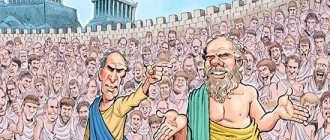Greetings, friends!
Surely you have come across people who manage to convincingly defend their point of view, even when they are obviously wrong. In Ancient Greece, there was a whole philosophical movement, within the framework of which those who could prove that they were right while being wrong were considered truly wise people. This movement was called sophistry, and its supporters were called sophists. Today we will look in detail at what sophistry is, learn the history of its appearance and development, and consider examples of sophistry. Let's begin!
Development of the concept "Sophist"
In the 5th century BC in Ancient Greece, a society of erudite teachers emerged who set themselves the goal of teaching their students the ability to argue (primarily for students to build their political careers). They introduced young people to the basics of history, law, mathematics and philosophy. But first of all, they taught methods of proof and refutation, discovered a number of rules of logical thinking, but soon, when victory in an argument became more important than proof of truth (which is important in politics), all attention was focused on developing logical tricks based on the external similarity of phenomena, on the fact that that an event is extracted from the general connection of events, from the polysemy of words, from the substitution of concepts, etc. These intellectuals were also called sophists.
Type of activity of the Sofia school
Schools of oratory were first mentioned in the 5th century in Sicily. But it was Athens that became the public arena for the educational activities of the Sophists. The doctrine touched upon the epistemological problem of philosophy. Adherents of the ancient school tried to teach followers to refute the conclusions of political opponents with the help of evidence and reasoning. In this endeavor, they encountered socio-political problems, for the sake of solving which they dealt with general questions of truth and falsity. It follows from this that philosophy, represented by the teachings of the Sophists, is an important direction in the science of thought in general.
Leading a traveling lifestyle, the sophists performed in front of everyone who wanted to learn eloquence. They “toured” cities, using pedagogical rhetoric to unite groups of people differing in age, gender, and social status. The sages made a huge contribution to the development of society - they cultivated an understanding of the importance of not only physical and spiritual education, but also mental education. Education acquired the highest value and became widespread. “An educated person is confident in himself, able to withstand the crowd, strong in thought, his weapon is the word,” thinkers were guided by this motto.
Due to their “wandering” lifestyle, the Sophists did not have a developed system of knowledge. The manuscripts have not survived to our time; we can study sophiology only on the basis of the works of philosophers of the late period.
History of sophistry
This philosophical movement arose in the 5th century BC. It was created by philosophers who called themselves sophists. Back then this word had a positive connotation. The Sophists themselves positioned themselves as teachers of wisdom. They taught other people philosophy, logic and, of course, rhetorical techniques. Very quickly they realized that the ability to prove any idea replaces real knowledge, so it was this skill that they taught their students.
In fact, the activities of the sophists quickly came down to the search for the most effective methods of arguing, usually dishonest. These techniques consisted of substitution of concepts, deliberate concealment of logical errors, and even psychological pressure. And in order to defend their right to such an approach, the sophists created a special philosophical ideology, within the framework of which it was argued that objective truth cannot exist. And if a person is able to prove a certain statement, it can be considered true.
The history of sophistry consists of two periods, which are conventionally called “senior” sophistry and “younger” sophistry. The most famous representatives of the “older” sophistry are Protagoras, Gorgias, Hippias and Antiphon. Among the “younger” sophists, the most famous are Critias, Alcidamas (Alcidamas), Callicles, Thrasymachus and Lycophron. Almost all the sophists were very rich people, since the rich willingly took wisdom lessons from them. At the same time, they were treated unkindly in society (they even got along poorly with each other and often got into arguments).
Sophistry as a direction of philosophy
Gradually, the Sophists became a group of philosophers, which today include (according to Wikipedia) Protagoras, Gorgias, Hippias, Prodicus, Antiphon, Critias, and the next generation after them - Lycophron, Alcidamas, Thrasymachus. Protagoras made the first attempts to systematize the methods of inference; he studied the categories of inflection and the syntax of sentences. Lycophron analyzed the role of the connective “is” in a sentence. Gorgias and others laid the foundations of the science of language. Prodicus developed the foundations of the doctrine of synonyms. At the same time, the sophists were not united within a certain “school”; their views did not have unity.
Peculiarities of the teachings of the younger sophists
This part of the history of sophistry has not been preserved very well, so there is little reliable information about the “younger” sophists. Famous representatives of the movement were Lycophron, Alcidamas, Thrasymachus, Callicles and Critias. Their ideas were based on the following theses:
- there should be no barrier between social classes;
- elite is an artificial concept, an invention of a group of people;
- nature created every person free, there should be no slavery.
The younger sophists talked a lot about ethics and morality, as well as about freedom and rights. In particular, Thrasymachus supported the ideas of democracy, extolled atheism and criticized religions.
What is sophistry? Examples of sophistry
The sophists were criticized for the fact that in disputes they skillfully used not so much logic as various tricks: substitution of context and concepts, distortion of definitions, play on words. These cunning techniques came to be called sophisms. Aristotle explained that sophistry is an “imaginary proof” that only appears to be true.
Read also: How to choose a kitchen stove
Sophisms are divided into two types:
- Logical sophism is based on a violation of logic: substitution of the thesis (main thought); on false premises; on a violation of the course of reasoning, an illogical conclusion, etc. Semantic sophism is based on manipulations with language - on ambiguity, metaphor, homonymy or polysemy of words. Because of this, thought loses its unambiguity, terms and concepts are confused.
Examples of sophistry
What you haven't lost, you have. You didn't lose your horns. So you have his horns.
One grain is not a heap. If you add another grain, it won't be a heap either. It turns out that if you add one grain to any number of grains, there will be no heap. This means that any amount of grain is not a heap.
The thief does not want to acquire anything bad. Buying something good is a good thing. Therefore, the thief means well.
Socrates is a man. Man is not the same as Socrates. So Socrates is not Socrates.
A person is able to see without the left eye and is able to see without the right eye. We have no other eyes. It turns out that a person does not need eyes to see.
Reasons for the appearance of sophistry in reasoning
There are several groups of reasons why a person begins to use syllogisms in argumentation. The reasons are intellectual, affective and volitional. Let's look at each of them in more detail.
Intelligent
These reasons are directly related to the intelligence of both sides of the argument. A more intellectually developed person can use sophistry if he knows for sure that:
- His opponent lacks knowledge in the area under discussion;
- If the opponent is too lazy to think, does not understand the flow of the argument and does not control it.
Affective
This category includes situations in which the “sophist” does not want to use his intelligence or simply lacks intelligence. Therefore, he simply appeals not to scientific concepts, but to feelings and emotions. A sophist who wants to succeed must understand psychology and skillfully find the weak points of his opponent. This awakens vivid feelings in the opponent’s soul, which cloud his thinking and do not allow him to draw logical conclusions. In addition, the rush of emotions often makes it impossible to think at all. Disputes in which the opponent avoids discussion and settles personal scores will also be considered.
Strong-willed
When the parties exchange opinions on any topic, they influence not only the emotions and feelings of the interlocutor, but also his will, since each argument contains an element of suggestion. This is expressed in facial expression, tone that does not tolerate objections, etc. However, not every enemy succumbs to this; it usually affects those who are passive and easily influenced.
The reasons for the emergence of sophistry are ambiguous
Features of the philosophy of the Sophists
It is not for nothing that other philosophers called sophistry deception. Gradually, these techniques moved away from philosophy, focusing entirely on ways to persuade an opponent in a dispute. The main tools of sophistry were:
- logics;
- terminology;
- psychology.
Sophists try to circumvent logic by violating the laws of syllogism. To do this, they typically introduce one correct and one incorrect premise, which are then combined to form a false conclusion. In the arsenal of sophists there are usually several techniques for working with words:
- play with meanings;
- use of synonyms, homonyms, homoforms;
- emphasis on unnecessary words;
- confusing phrases, etc.
The norms of morality and ethics among the sophists appear completely arbitrarily depending on the time frame. These norms are interpreted from the point of view of relativism (i.e. the theory of relativity), i.e. the sophists argued that the same person can perceive the same phenomenon in different ways, depending on many influencing factors (mood, state, etc.).
The philosophical views of the sophists and sophism were criticized by such outstanding thinkers as Socrates and Plato. Critics also included representatives of the Socratic schools, such as the Cynics, Megarics and Cyrenaics. Subsequently, gradually there were fewer and fewer constructive philosophical ideas in the teachings of the sophists. Sophistry eventually reached the level of “quality rhetoric,” that is, only rhetoric and the art of winning arguments remained, but calling it the art of thinking would not be entirely accurate. Although, of course, at the most banal and everyday level it can be called exactly that.
Peculiarities of the teachings of the “senior” sophists
The first sophists sought knowledge. At the same time, they stemmed from the fact that the knowledge accumulated by humanity was largely erroneous. Today it is their teaching that is first turned to to explain what sophistry is. They studied the problems of all the sciences that existed at that time and questioned established religious beliefs. In fact, the “old” sophists were originally skeptics who subjected absolutely everything to critical analysis. They didn't deny anything, they just gave arguments for and against.
All “senior” sophists can be divided into three groups:
- Speakers. This group spoke the language and could perfectly argue their point of view.
- Arists. They were arguers who argued for the sake of arguing. They fought to win the debate at all costs, and for this they were condemned by many.
- Politicians. These sophists used their skills and knowledge to achieve political goals.
Among the senior sophists, Protagoras is the most famous. He was undoubtedly a very wise and prudent philosopher for his time. He is believed to have been the founder of the central thesis of sophistry, that man is the measure of all things, and that the essence of all phenomena is determined by how man perceives them.
Protagoras emphasized the relativity of truths, denying their absoluteness. It is also believed that this philosopher was the first to develop the idea of a democratic society. He also talked a lot about how lawlessness can be defeated with the help of correct argumentation.
Protagoras' most famous student was Socrates, who distinguished himself by opposing his teacher and other sophists. Instead of rejecting the existence of absolute truth, he believed that such truth existed and was determined by a divine being.
Another famous "senior" sophist was Horgias. He is considered the founder of rhetoric. He is famous for saying that one action can be considered either bad or good - it all depends on your point of view. The name of Hippias, who was famous for his eloquence, has also been preserved in history. His teaching was highly respected, and he himself, unlike most sophists, managed to get rich while maintaining his good name.
Peculiarities of the teachings of the “younger” sophists
This part of the history of sophistry has not been preserved very well, so there is little reliable information about the “younger” sophists. Famous representatives of this movement were Lycophron, Alcidamas, Thrasymachus, Callicles and Critias. Their concepts were based on the following theses:
- there should be no barriers between social classes;
- elite is an artificial concept, an invention of a certain group of people;
- Nature created every person free; There should be no slavery.
The younger sophists talked a lot about ethics and morality, as well as about freedom and rights. In particular, Thrasymachus supported the ideas of democracy, extolled atheism and criticized religion.
Sophistry
Sophistry is the teaching of ancient Greek teachers of eloquence, the essence of which is the use of sophisms. Sophistry (a cunning invention, a trick) is an erroneous reasoning that looks logical, the purpose of which is to lead a person to a deliberately incorrect conclusion, to confuse, to deceive.
In sophistry, there are several main types of logic used.
Pragmatic logic
Pragmatic logic is formal logic that uses sophisms. The goal of pragmatic logic is to achieve a psychological sense of rightness. Rightness and truth are not the same thing. This can be seen in soldiers shooting at each other or police clashing with protesters. Each believes that his side is right and the other is wrong. From the point of view of formal logic, it is impossible to draw a single straight line using 1 point, but it is possible to draw a single straight line using 2 points. From the point of view of pragmatic logic, it is possible. Take you wherever you like. Pragmatic logic is often called “feminine” logic, since it is used more often by women, although, it seems to me, officials use it more often.
Thanks to pragmatic logic, for example, when several people argue on some issue, all participants in the dispute may turn out to be right.
And this is possible when the dispute between them is conducted on different planes. For example, 1 talks about the financial plane of the issue (let’s lower the retirement age and there will be additional money in the budget), another about the moral one (people don’t live up to this age, how can you deceive the whole life of working people like that), the third about the temporary one (let’s raise the age now, and then we will pay more pension).
Different planes of dispute from the point of view of formal logic are a violation of the law of identity. Those who want to prove that they are right most often resort to violating this particular law using analogies.
There can be only one truth lying in one plane of the dispute on a specific issue (a specific issue means that there cannot be an opinion on it), except in the case when the struggle is to clarify the benefits. (we shared the orange, but one needs the peel and the other the pulp) Then the benefit is “split” in half and both sides win.
Another example: two people drove onto a narrow street and flashed their headlights at each other, but one clarified the advantage, pressed against the edge and the second was able to pass.
Third example. A husband and wife live with their mother-in-law, the mother-in-law left, and they decided to get a divorce. When they lived together, they won at the expense of the third party, and the third party lost. When there was no third party, they began to quarrel with each other. Friendship often unites against someone.
Option 4, when both give up benefits in order to preserve the relationship.
Option 5 – re-labeling. Replace a benefit with another that can be received by both parties.
Those. 5 options for both sides to win: compromise, clarification of the benefit, gain at the expense of the 3rd party, refusal of the benefit and re-labeling.
Eclectic logic
Eclectic logic – the goal is to obtain an image of truth. Formal logic may not be violated, but dogma is taken as the basis for logical constructions. An example is books on scientific proof of the existence of God. Create a feeling of proof. Lobbyists for tobacco, alcohol, and oil corporations. They are often used by scammers to create a feeling of awareness of an issue by talking about facts that are close to the object of discussion, but are not it.
Intuitive logic
Intuitive logic is the goal of making a management decision based on feelings (emotions) dictated by empirical life experience. All the arguments are against it, but inside there is a feeling that we need to do it differently. You do it and you get what you need.
Pseudologics
– its purpose is to persuade yourself to make a decision that you have already made. And here, no matter what arguments are given, it is useless to convince them because the decision has already been made.











